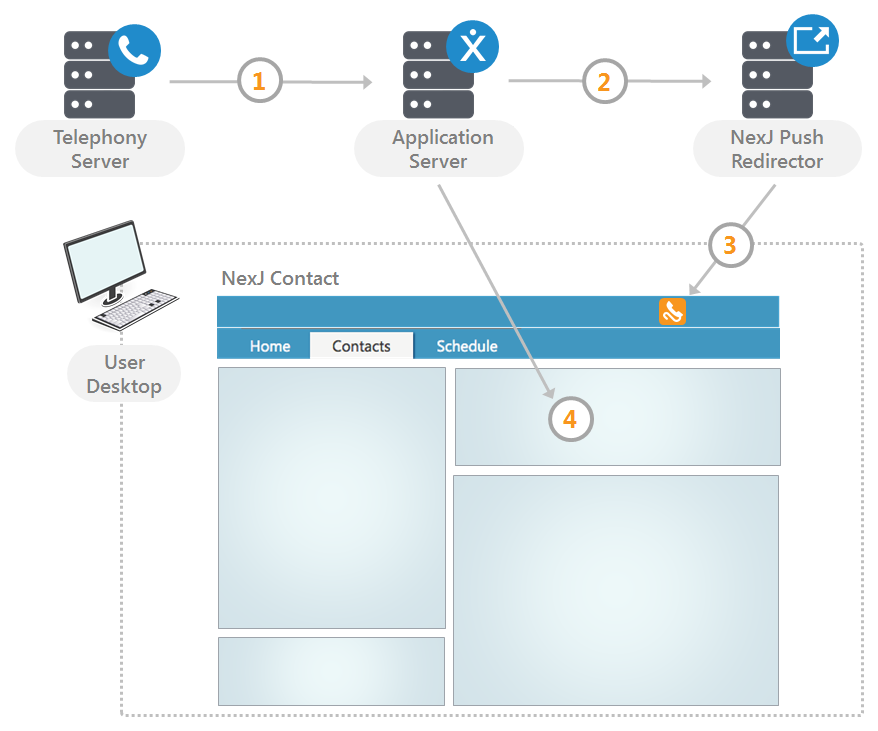Inbound call handling
The following diagram illustrates the path that inbound calls follow from a telephony server to NexJ CRM:

- Telephony server
- The server component of an IP-based telephony system. The telephony server notifies the application server of inbound calls and call details.
- Application server
- The server that delivers NexJ CRM to the user.
- Push redirector
- The server that sends an inbound call notification message to the user's browser, which then displays a notification beacon to the user.
- NexJ CRM
- The CRM application running on the user's desktop.
- When a user answers an inbound call, a Remote Procedure Call (RPC)
message is sent from the telephony server to the application server.
The message identifies the user who answered the call, the telephone
number of the caller, and other relevant information.Note: RPC messages can have more than one source. As long as a message source is authorized, it can send a message to the application server.
- The application server sends a notification about the user being called to the push redirector.
- The push redirector displays the notification beacon. The beacon appears as the flashing telephone icon in the user's application toolbar to indicate that inbound call information is available.
- When the user clicks the telephone icon, NexJ CRM
creates a User Call State record and displays a new Inbound
Call workspace. NexJ CRM
uses information from the RPC message to identify the caller and
retrieve their information.Note: A user can have multiple Inbound Call workspaces open. This allows the user to record all desired details about a call before saving the final record.
To end a call, the user hangs up their phone. The telephony server sends a message to the application server to indicate that the call is disconnected. The details of the call are then cleared from the User Call State record.
User Call State record
Details for inbound calls are stored in the system in a User Call State record. The User Call State record contains the following fields:
| Field | Description |
|---|---|
| User | The call center agent (NexJ CRM user) receiving the call. |
| Has the user clicked the beacon | Whether the telephone icon for an inbound call continues to flash. If the user has not clicked the icon, then it continues to flash. If the user has clicked the icon to answer the call, then it no longer flash. |
| Phone Number | The telephone number of the caller. The number is used to perform a contact search that matches the caller to an existing contact. |
| Status | The call state of the user. There are two states:
|
| Call Reason | A code used to retrieve the appropriate call script. The call reason is typically mapped from the sequence of numbers dialed by the caller through an interactive voice response system (IVR). |
NexJ CRM populates the User Call State record and sets the status to Connected when the telephony server indicates that the user has answered a call. When the application server receives a message from the telephony server to indicate that the call has ended, the call details are cleared from the User Call State record and the status is set to Disconnected. The User Call State record always retains call details until a call is disconnected.
The User Call State record can be modified at design time to accept additional information. The information is passed in the inbound call message and stored in the User Call State record. For example, the User Call State record can be modified to store telephony details and information gathered by the IVR, such as the user's account number, what telephone number the caller dialed, and whether the user is authorized by the IVR.
